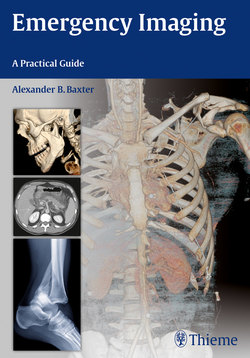Читать книгу Emergency Imaging - Alexander B. Baxter - Страница 107
На сайте Литреса книга снята с продажи.
Оглавление95
3 Head and Neck
pia on upward gaze may be due to orbital edema or impingement of the inferior rec-tus muscle by an orbital floor bone frag-ment. Other clinical findings include pain with mastication from associated man-dibular coracoid process and temporalis muscle impingement.
CT with multiplanar reformations lo-cates the fracture components, the de-gree of malar fragment displacement and rotation, and any associated soft tissue or ocular injuries. The infraorbital canal (containing the maxillary nerve), orbital contents, nasolacrimal duct, and medial canthal ligament attachment should be specifically examined (Fig. 3.4).
◆Zygomaticomaxillary Complex Fracture
The zygomaticomaxillary complex (ZMC) fracture results from a direct blow to the cheek and comprises the following frac-tures: (1) zygomatic arch, (2) lateral orbital wall (or diastasis of the zygomaticofacial suture), (3) inferior orbital rim and floor, and (4) anterolateral maxillary sinus wall. As they involve all four zygomatic articu-lations, the ZMC fractures eectively sep-arate a malar fragment from the lateral facial skeleton. ZMC fractures can be vari-ably rotated or depressed. Clinical findings include a palpable step-o at the inferior orbital rim or zygoma, subcutaneous em-physema, and hyperesthesia or anesthesia over the cheek (CN V2 distribution). Diplo-
Fig. 3.4a–fa,b Zygomaticomaxillary complex fracture. Minimally displaced right zygomatic arch, anterior and pos-terolateral maxillary sinus wall, orbital rim, and orbital oor fractures. Right zygomaticofrontal suture diastasis.
c–fZygomaticomaxillary complex fracture. Posterior displacement of the malar fragment with soft tissueemphysema. Right zygomatic arch, anterior and posterolateral maxillary sinus wall, orbital rim, and orbitaloor fractures. Right zygomaticofrontal suture diastasis. 3D reconstruction shows the malar fragment.
